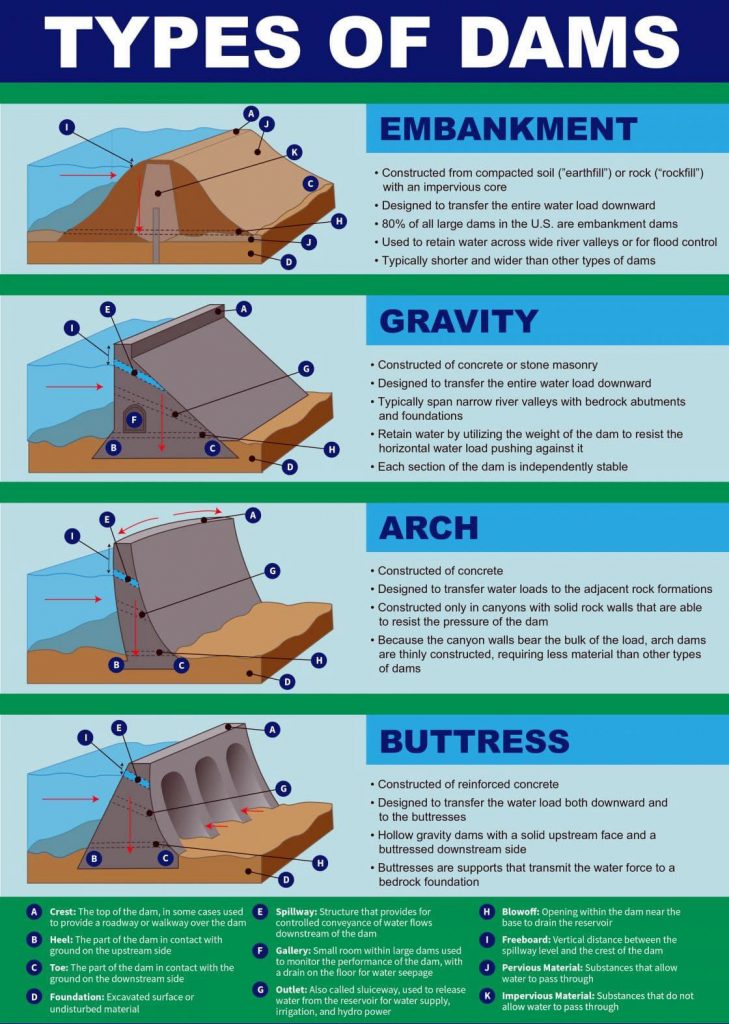Context:
The southwest monsoon may have covered the whole of India, but the level of water in reservoirs remained below normal in five states: Himachal Pradesh, Punjab, Rajasthan, Nagaland and Madhya Pradesh.
Relevance:
GS-I: Geography (Water Sources), GS-III: Environment and Ecology (Conservation of water and other resources)
Dimensions of the Article:
- Introduction to Water Crisis in India
- Dams in India
- What is the Difference between a dam and reservoir?
- Issues with Ageing Dams in India
- About the current state of low Reservoir levels
- Dam Rehabilitation and Improvement Project (DRIP)
Introduction to Water Crisis in India
- India has 4% of the world’s freshwater which has to cater to 17% of the world’s population.
- As per NITI Aayog report released in June 2018, India is facing the worst-ever water crisis in history. Approximately 600 million people or roughly around 45% of the population in India is facing high to severe water stress.
- The report says that nearly 40% of the population will have absolutely no access to drinking water by 2030 and 6% of India’s GDP will be lost by 2050 due to the water crisis.
- The Central Groundwater Board’s estimates show that the groundwater table in most parts of the country has been declining every year because of over-exploitation.
- India has the dubious distinction of being the world’s largest user of groundwater by far, even as the water table has been falling by an average of 0.4 m nationally.
- Due to accumulation of sediments in the water storage area of major and medium irrigation dams that are currently in use, the total storage capacity has fallen significantly.
- 85% of rural water supply, 45% of urban water supply and over 64% of irrigation now rely on groundwater so if the groundwater continues to decline unabated, meeting the country’s agricultural and drinking water requirements will become a big challenge.
Dams in India
- India has 4,407 large dams, the third highest number in the world after China (23,841) and the USA (9,263).
- India is ranked third in the world in terms of building large dams.
- Tehri Dam in Uttarakhand is the highest dam in India built on Bhagirathi River.
- Hirakud Dam in Odisha built on river Mahanadi is the longest dam of India.
- Kallanai Dam in Tamil Nadu is the oldest dam of India. It is built on the Kaveri River and is about 2000 years old.
What is the Difference between a dam and reservoir?
- An easy distinction to remember is that a dam is a physical structure that retains water; a reservoir is the water body that is created by a dam.
- Reservoir is an open-air storage area (usually formed by masonry or earthwork) where water is collected and kept in quantity so that it may be drawn off for use.


Issues with Ageing Dams in India
- As dams age, soil replaces the water in the reservoirs. Therefore, the storage capacity cannot be claimed to be the same as it was in the 1900s and 1950s.
- Studies show that the design of many of India’s reservoirs is flawed in the sense that the designs underestimate the rate of siltation and overestimate live storage capacity created.
- When soil replaces the water in reservoirs, supply gets choked. The cropped area begins receiving less and less water as time progresses.
- The net sown water area either shrinks in size or depends on rains or groundwater, which is overexploited.
- The designed flood cushions within several reservoirs across many river basins may have already depleted substantially due to which floods have become more frequent downstream of dams.
About the current state of low Reservoir levels
- The Central Water Commission (CWC) said that the level of water in the reservoirs of Himachal Pradesh and Punjab were the most deficient with only about 50% of the usual capacity.
- The level in reservoirs in Nagaland was about 35% below normal levels and about 10% below usual levels in Rajasthan and MP.
- The country’s overall storage in 2021 is also less than the corresponding period in 2020, but is better than the average storage of last ten years during the corresponding period.
- The northern region has the lowest storage as per its capacity.
- All southern states — Andhra Pradesh, Telangana, Karnataka, Kerala and Tamil Nadu have better storage in 2021 than in the corresponding period in 2020. The reservoirs still have capacity to absorb more rainfall.
Dam Rehabilitation and Improvement Project (DRIP)
- Dam Rehabilitation and Improvement Project (DRIP) was started in 2012 and aims to improve the safety and performance of selected existing dams and associated appurtenances in a sustainable manner.
- DRIP also has the objective of strengthening the dam safety institutional setup in participating states as well as at the central level and exploring alternative incidental means in few of selected dams to generate the incidental revenue for sustainable operation and maintenance of dams.
- It also aims at ensuring the safety of downstream population and property that are affected in the case of a dam failure or operational failure.
-Source: Down to Earth Magazine




